Ventilation in houses with gas stoves: rules and regulations in the organization of stable air exchange
The desire to save on utility costs is common to most of us. And you must admit, the transition to the use of natural gas for cooking and heating is the most optimal way of such frugality. But ventilation in houses with gas stoves must be built according to very strict rules.
You will learn all about the requirements for the design of a kitchen exhaust system from the article we submitted. We will introduce the regulation of regulatory documentation, detailing in detail all sides of this difficult issue. We will analyze standard options for organizing an air mass removal system.
The content of the article:
Air exchange requirements
When designing ventilation in kitchens with gas stoves, it is necessary to comply with the requirements of both sanitary and fire safety standards (GOSTs, SNiPs, SanPiNov and SP). Gas supply of apartments and cottages is an undoubted benefit, as it allows to significantly reduce the cost of a communal apartment. But there are a number of points.
Both delivery options: transported by pipe trunk gas and LPG from a gas tank or cylinder is a source of danger. You can not neglect the prescriptions and forget about the safety rules.
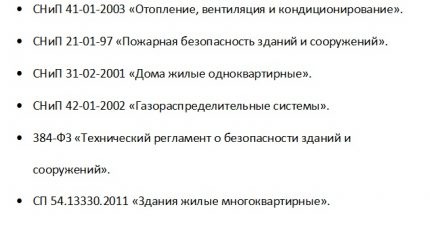
If the hood and air flow in the gasified kitchen room is not organized correctly, then the room can become a source of serious problems associated with open fire and a possible explosion of "blue fuel".
Gas stoves are allowed to be installed both in private houses and in multi-unit buildings. The height of the building can be no more than 10 floors. At the same time, the premises for them should have a window and be well lit by natural sunlight.
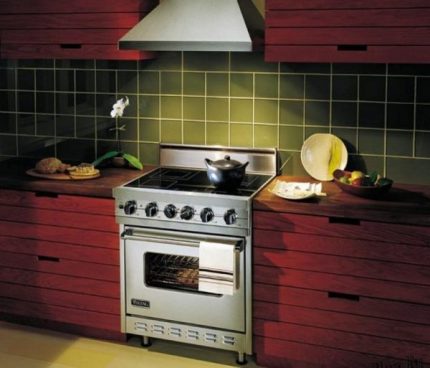
The kitchen for installing a gas stove should:
- be with ceilings with a height of 2.2 m and above;
- have ventilation with natural air intake / removal;
- have a window that has an opening sash either at the top of the transom or window.
The cubic capacity of a room with a gas stove should be at a minimum (and preferably more):
- 8 m3 - at two rings;
- 12 m3 - at three rings;
- 15 m3 - at four rings.
In some cases, it is permissible to depart slightly from these standards, but only subject to the coordination of such deviations with inspectors from the Ministry of Emergencies and other regulatory bodies.
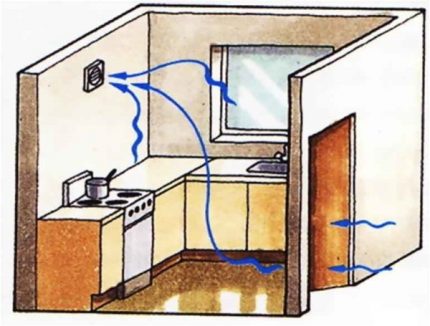
When organizing air exchange in the kitchen It is important to ensure that new air comes exclusively from the street. This will prevent air masses from entering the kitchen room with excess odors and moisture, as well as low oxygen content. Only methane or propane-butane gas stoves are not enough to work.
Air exchange rate for a kitchen with a gas stove - 100 m3/hour. Moreover, in most apartment buildings, ventilation ducts with a width of 130–150 mm of the general ventilation system are designed for a flow of up to 180 m3 / hour.
It is only required to provide the required air flow from the outside. In a private house it all depends on the project. Here it is necessary to look at a concrete example of what the existing ventilation system.
Ventilation arrangements for a gas stove
Ventilation in the kitchen where the gas stove is installed can be:
- forcibly
- with natural motivation;
- combined.
Any option is allowed. However, according to fire safety standards, air exchange in the room in question must be natural. The forced system with a fan is volatile, it is permissible to use it only as a supplement.

If the kitchen is set cooker hood and withdrawal to the riser, then for its proper operation:
- it is necessary to ensure the flow of air into the room in the proper amount;
- it is forbidden to close the ventilation duct with natural ventilation with a new outlet pipe;
- it is necessary that the ventilation riser is able to pass the volume of air blown into it.
If the ventilation is rebuilt under a gas stove in the cottage, then there will be a minimum of problems with the expansion and reconstruction of ventilation ducts. It only takes money and time to work.
But if a gas stove and ventilation for it are mounted in an apartment of an apartment building, then the situation is often awful. Not every high-rise building, if this was not originally laid down in the project, is designed to install gas equipment in it.
At a minimum, you will have to mount window and wall valves for additional influx of street air. Established ventilation ducts and existing air inlets are unlikely to be designed for the required parameters.
What can and should be done?
If the existing ventilation system is capable of providing air exchange of 100 m3/ hour, it’s enough just to put the cooking stove with its connection to the gas. And you can start cooking your own food. Otherwise, when installing a gas stove, ventilation in the apartment and cottage will have to be modified in two directions - the first is an influx, and the second air exhaust.
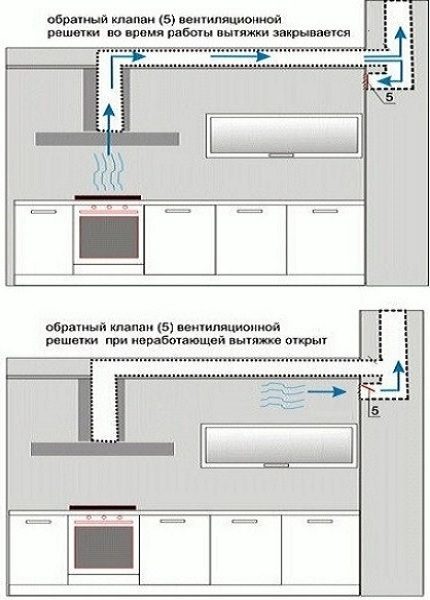
Additional air flow is provided by:
- drilling holes in the street exterior wall and mounting a ventilation valve therein;
- installations on kitchen windows of supply valves;
- increased clearance under the door to the kitchen.
In the general situation, air inflow is provided from the street and from other rooms of the house.But in the case of a kitchen and a gas stove, most of it should go outside.
At the same time, it is permissible that it comes from a window in the bedroom or living room, but then the clearance from the flooring under the kitchen door will need to be made larger than the standard 15–20 mm. Here the door leaf will have to be lifted 20-30 mm. If you mount it lower to the floor, then the air exchange will be insufficient.
Supply valves are recommended to be made in wall execution. Window analogues in frost can freeze and stop supplying air. The options in the wall are larger and free from icing problems.
If the house is old, then without supply valve installation not enough. Soviet-built buildings were originally designed for ventilation due to the natural influx of air through leaking doors and wooden windows.
However, double-glazed windows and doors with gaskets are now being installed everywhere. As a result, the norms of air exchange laid down in the project are violated everywhere, often due to banal ignorance.
As a result, the ventilation system does not cope with the task, and a gas stove is added, which needs additional volumes of oxygen to work. Without supply valves air to provide the proper microclimate in residential premises in this case is often impossible.
What is prohibited to do?
In old houses, ventilation ducts were often made using parts made of wood. Plus, they may contain cables for power supply and / or communication systems. In such mines, it is forbidden to remove the tap from the hood above the gas stove.
The products of combustion from a gas-fired furnace have an elevated temperature and also contain water vapor, CO and CO2. Pulling such a cocktail into the ventilation duct, which is not intended for this, is impossible.
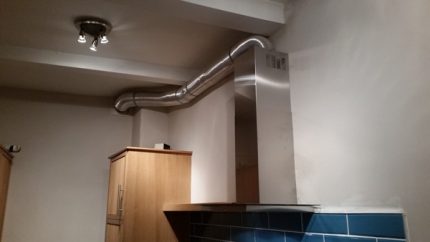
On the one hand, ventilation ducts in a kitchen with a gas stove should ensure proper air exchange, and on the other, exclude the possibility of fire from natural gas combustion products.
Another point is the purchase and installation of a forced-hood hood in the kitchen. Sellers of such equipment praise their goods and recommend that they purchase equipment more powerful for 900–1100 m.3/hour. However, more power in this situation is more likely harm than good.
If the ventilation hole in the wall and the shaft-riser in diameter are designed for a pass of 180-200 m3/ hour, then they’ll not be able to physically pump through themselves much more.
Even if the "umbrella" will buzz at full power and push a larger volume of air, the channel will not be able to pump it. As a result, either the “hood” will work idle, or reverse thrust will form in the mine. From both options, the sense of zero.
Difficulties often also arise when the apartment is on the top floor of a high-rise building. In a similar situation, ventilation in the kitchen often works poorly. The diameter of the ventilation duct allows to ensure natural air exchange at the proper level, and there is practically no traction.
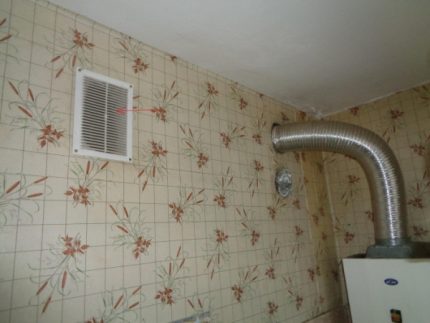
In order for the required draft to form, the air flow from the room must fall into a vertical pipe, and then pass through it unhindered for at least 2 meters. However, on the top floor, the air vent in the kitchen is located under the ceiling and does not provide the required distance.
From above, only the attic and to the end of the ventilation shaft, which breaks off there, remains less than half a meter. As a result, air exchange occurs, but it is too small for a gas-fired stove.
In this situation, it will be necessary to install an additional vertical pipe of the required height, otherwise it will be impossible to provide ventilation requirements in a room with a gas stove. Forced hood can solve this problem.But when the light is turned off, the fan will stop working, which is already prohibited by fire regulations.
Conclusions and useful video on the topic
Rules for choosing a cooker hood with forced motivation:
The successful design of a homemade hood for a gas stove:
The most characteristic violations in ventilation systems in kitchens with gas stoves:
To prevent a kitchen with a gas stove from becoming a fire place, the ventilation system in it must be with a natural motivation and meet the requirements of SNiPs according to the norms of air exchange per hour.
And when installing an additional hood, one should not forget about ensuring the proper air flow from the street. Due to its low cost, natural gas allows saving, but it is difficult to call it completely safe. It is not worth neglecting the instructions of fire and sanitary standards.
Please leave comments in the block below, post a photo on the topic of the article, ask questions. Share your experience gained while ventilating in a gasified kitchen. Tell us about the technological nuances that will be useful to site visitors.

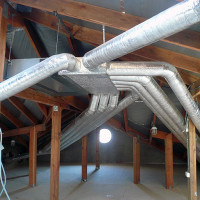 Cottage ventilation: options for organizing an air exchange system + device rules
Cottage ventilation: options for organizing an air exchange system + device rules 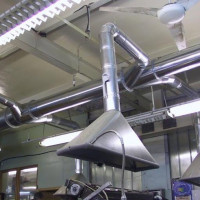 Ventilation of industrial premises: rules for the organization of air exchange
Ventilation of industrial premises: rules for the organization of air exchange 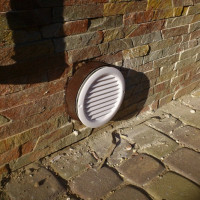 Ventilation of the foundation of the house: rules and options for organizing air exchange
Ventilation of the foundation of the house: rules and options for organizing air exchange  Frequency rate of air exchange in office premises: norms and rules for the organization of proper air exchange
Frequency rate of air exchange in office premises: norms and rules for the organization of proper air exchange 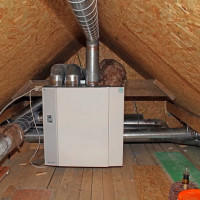 Ventilation in a two-story private house: options for organizing trouble-free air exchange
Ventilation in a two-story private house: options for organizing trouble-free air exchange 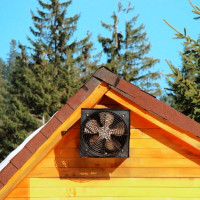 Ventilation in a wooden house: rules for providing a log house with an air exchange system
Ventilation in a wooden house: rules for providing a log house with an air exchange system  How much does it cost to connect gas to a private house: the price of organizing gas supply
How much does it cost to connect gas to a private house: the price of organizing gas supply  The best washing machines with dryer: model rating and customer tips
The best washing machines with dryer: model rating and customer tips  What is the color temperature of light and the nuances of choosing the temperature of the lamps to suit your needs
What is the color temperature of light and the nuances of choosing the temperature of the lamps to suit your needs  Replacement of a geyser in an apartment: replacement paperwork + basic norms and requirements
Replacement of a geyser in an apartment: replacement paperwork + basic norms and requirements
When building my house, do I need to coordinate a ventilation project with someone?
Hello. For a private house, you do not need to coordinate the design of the ventilation system in any structures. But if you want the ventilation to function properly, then the project must be in accordance with SNiP.
Many save on ventilation when building a house, but actually getting a ready-made ventilation project for a house is not so expensive. Given, of course, that you yourself will implement it.
The project includes:
- technical task;
- detailed explanatory note;
- formulas and calculations;
- detailed drawings of vent. systems;
- specification for recommended equipment;
- Feasibility studies, due to which the equipment was selected.
If you want to make and calculate a project yourself, then the simplest formula is according to the number of people.